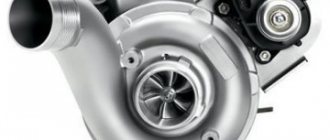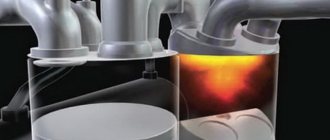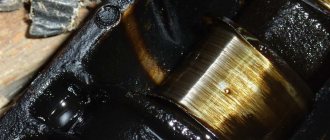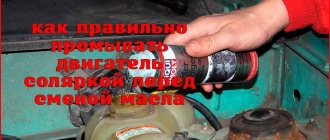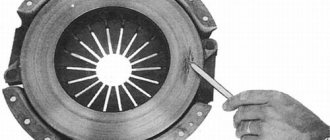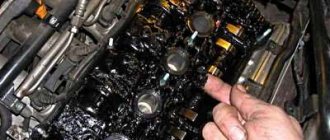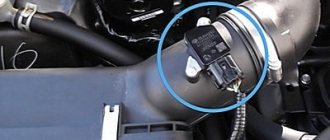01.09.2020
| (Votes: 1, Rating: 5) |
Issues discussed in the material:
- The main signs of oil getting into antifreeze
- Why does oil get into antifreeze?
- Consequences of oil getting into antifreeze
- Diagnostics and troubleshooting
- Experienced car enthusiasts explain why oil gets into antifreeze
When oil gets into antifreeze, the consequences can be very different: from deterioration of the cooling system to breakdown of the power unit. Timely diagnosis and elimination of the cause will help save the engine from failure, but troubleshooting can be quite difficult.
A broken cylinder head gasket or worn-out heat exchanger elements can cause oil to get into the antifreeze. In addition, there is often a lack of tightness of the cooling system. However, whatever the reason, repairs cannot be delayed, otherwise antifreeze diluted with oil can lead to very expensive consequences.
The main signs of oil getting into antifreeze
There is a list of signs indicating that oil has leaked from the engine into the coolant. You should not waste time finding out the exact amount of lubricant in antifreeze. Below are signs that indicate the need to urgently fix the problem. Ignoring it will inevitably lead to a serious engine malfunction, which will be very costly to fix financially.
How to tell if oil is getting into antifreeze:
- The color and consistency of the antifreeze changes. In normal condition, the coolant is transparent with a green, yellow or red tint. Under the influence of natural factors, antifreeze darkens just in time for the end of its scheduled service life. If this happened much earlier or the density of the liquid became greater, foreign inclusions, oil or fat impurities appeared, this means that engine oil has entered the cooling system.
This will also be indicated by an oily film on the surface of the refrigerant in the expansion tank. It is clearly visible even to the naked eye, gives the coolant a dark color and shimmers with all the colors of the rainbow due to its good reflectivity (diffraction effect).
- Antifreeze feels oily to the touch. To detect this, you need to rub a small amount of liquid with your fingers. Chemically pure coolant evaporates quickly, but in the presence of oil this will be immediately felt by the skin of your hands.
- Unpleasant smell of coolant. Normal antifreeze either does not smell at all or emits a sweetish odor. However, when mixing oil, a burning smell appears. The intensity of the odor increases as the amount of oil in the liquid increases.
- Repeated overheating of the motor. Oil in antifreeze inevitably impairs its performance properties. That is, it cannot properly cool the engine. In particular, the boiling point of antifreeze decreases. It is for this reason that fluid is squeezed out through the cap of the expansion tank or radiator. This phenomenon is more often observed during the hot season of the year. In turn, overheating can provoke a deterioration in the performance of the motor - it begins to stall.
- Oil stains appear on the walls of the expansion tank of the car's cooling system.
- Oil deposits can be found on the radiator cap and expansion tank (inside). An emulsion of antifreeze and oil begins to appear from under the cap.
- When the engine operates at high speeds, air bubbles appear in the expansion tank fluid. This is clear evidence that oil is getting into the antifreeze.
Therefore, if you notice at least one of the signs described above on your car, you must definitely check the coolant and the cooling system itself, and then start looking for possible causes of the malfunction. You also need to check the opposite effect - whether there is antifreeze in the oil. And this requires knowledge to understand how antifreeze gets into the oil.
How to solve a problem
First of all, it is necessary to find out the reason for the appearance of oil in antifreeze. If the lubricant has penetrated into the cooling system line through a crack, then there is nothing special to advise car enthusiasts.
In any case, the engine will have to be overhauled by replacing the damaged element. Or look for and install a new motor, which often turns out to be a more rational option.
Once the cause is discovered, a complete replacement of the lubricant and antifreeze will be required. This is almost always mandatory. It rarely happens that mixing of working fluids occurs in only one direction. To some extent, antifreeze will penetrate into the oil. And this will lead to a decrease in lubricating properties.
Oil in the coolant leaves a residue on the walls of the radiator, pipes, cooling jackets, as well as the pump and thermostat. This introduces some peculiarities into the troubleshooting procedure.
What you need
Oil getting into the engine cooling system is a very unpleasant problem that will require labor-intensive operations. To properly restore engine performance, regardless of the source of the problem, you will need the following:
- double or triple the volume of distilled water required to completely fill the engine cooling system (using ordinary water is highly discouraged, as it will leave deposits on the walls of the lines);
- cooling system cleaner (there are several such products on the market today, for example, Hi-Gear Radiator Flush, Liqui Moly Pro-Line Kuhler Reiniger or Fenom Old Chap);
- clean rags for cleaning the upper walls of the tank from oil;
- empty container for draining;
- new antifreeze (you must check which coolant the car manufacturer recommends);
- motor or transmission lubricant, depending on how the oil got into the antifreeze.
In addition to this set, the degree of reverse penetration must be taken into account. It is imperative to remove the valve cover and look at the condition of the oil under it. If there is an emulsion, even in small quantities, we additionally purchase a flushing composition for the engine lubrication system.
With automatic transmission everything is a little more complicated. Here, in the event of abundant water entering the gearbox lubrication system through the heat exchanger, it is advisable to rinse the valve body not with a passing stream, but directly by disassembling it. And these are serious operations that require high qualifications.
Why does oil get into antifreeze?
How to find the reason why oil gets into antifreeze? The most common ones are listed below:
- cylinder head failures, including:
- sleeve corrosion;
- gasket wear;
- microscopic cracks on the surface of the cylinder head;
- other breakdowns of parts;
- mechanical faults in the oil cooler and oil cooler;
- wear of the heat exchanger gasket;
- defects in the pipes or radiator of the cooling system;
- cylinder head deformation;
- pump shock absorption;
- damage to the expansion tank;
- violation of the integrity of the oil system pipes.
Oil gets into the antifreeze due to the use of incompatible fluids. For example, a car owner discovered a low refrigerant level and replenished it with the first available one. However, the additives contained in antifreeze can enter into unpredictable reactions with each other, which may result in damage to the elements of the cooling system.
We recommend
“Where can you change the oil, and how best to do it” Read more
The engine lubrication system and the cooling circuit are absolutely not connected with each other. But the reasons why engine oil gets into antifreeze have been well studied. Below we will find out the sources of these malfunctions.
- Over-tightened cylinder head fasteners or errors during its installation at a service station can cause gasket deformation. Since the oil is under greater pressure than the coolant, it begins to be squeezed out into the antifreeze.
- Cracks on the surface of the cylinder head as a consequence of poor quality repairs of this unit.
- Oil in antifreeze may be a sign of a faulty oil cooler. To clarify this diagnosis, you need to disassemble and wash the pipes and replace the refrigerant. Then check for bubbles in the antifreeze in the expansion tank after operating the machine for a short time. The absence of these indicates that the malfunction was in the cooling system.
For diesel cars with an intercooler (turbine radiator), if oil is detected in the refrigerant, the reasons are somewhat different:
- violation of the integrity of the oil pipeline;
- the appearance of cracks in the radiator;
- destruction of the air vent due to wear or blockage;
- oil filter malfunction;
- insufficient crankcase ventilation, which indicates the need for engine overhaul.
Often, owners of diesel cars do not pay attention to obvious signs of the presence of oil in antifreeze. As a result, the machine suddenly becomes completely inoperable. But if you take immediate action immediately after detecting a malfunction, it will be cheaper than major repairs or complete loss of the car in case of an advanced problem. Harsh statistics show that half of car engine malfunctions occur due to oil being mixed into the refrigerant.
Tips and tricks
As you can see, there is a whole list of possible problems that lead to oil getting into the cooling system and vice versa. It is important to understand that after eliminating the problem, it is imperative to change both the lubricant in the oil system and the coolant in the cooling system.
Moreover, before adding fresh fluids, both systems must be thoroughly flushed. For example, if coolant got into the oil due to the water pump, even after simply replacing the pump, there will be a small amount of liquid in the pan. This means that the existing oil will lose its properties to one degree or another.
Let's imagine a common situation. Let's say the pump was changed, the oil was drained and new oil was added, but without flushing. In this case, up to 10-15% of the old grease mixed with antifreeze will still remain in the pan. So, if you do not flush the oil system first, then the additives in the fresh oil can react with the residues, create deposits and sludge, quickly contaminate the new oil filter, etc.
To prevent this from happening, you can go in two ways:
- remove the tray to remove residues;
- flush the oil system with flushing oil;
We also recommend reading the article about what to do if an emulsion appears on the oil level dipstick and under the oil filler cap. From this article you will learn about the reasons for this malfunction and the available ways to fix the problem.
Although the first option is more difficult, this method is more effective. At the same time, the second method does not require disassembling the internal combustion engine and is simple, as a result of which it becomes the choice of the vast majority of drivers.
Consequences of oil getting into antifreeze
Car owners are often interested in what to do if the presence of oil in the refrigerant is detected, and whether it is possible to continue operating the car. The answer to the question very much depends on the amount of lubricant that gets into the antifreeze. It is ideal when, even with a small volume of oil mixed into the coolant, the car is taken to a garage or car service center, where repairs are made - either on its own or with the assistance of specialists. But anything happens in life, so it is allowed to move a short distance after detecting the presence of a small amount of engine oil in the refrigerant.
You need to be aware of exactly what harm the oil causes when it gets into the antifreeze. First of all, this deteriorates the working properties of the coolant, which means that the engine is not cooled sufficiently. In addition, damage is caused to the cooling system as a whole.
Also, when this malfunction occurs, not only oil is mixed into the antifreeze, but also antifreeze is mixed into the oil, which inevitably causes serious problems with the operation of the engine. If antifreeze gets into the oil, how can you tell? It is better to quickly contact professionals, because any delay can provoke the development of more serious malfunctions. And this means significant financial costs for their elimination. A quick response to problems with the cooling system in the summer is especially important, when its proper functioning is especially important for the internal combustion engine.
If, despite the engine oil getting into the antifreeze, the vehicle continues to be used, then the following malfunctions are likely to occur in the engine compartment:
- Constant overheating of the internal combustion engine, most likely in hot weather or during high load (at high speeds).
- Clogging of the cooling system components (radiator segments, pipes and hoses), reducing performance to an unacceptably low value.
- Destruction of non-oil resistant parts of the cooling system, such as plastic and rubber.
- A significant reduction in the service life of not only the internal combustion engine cooling system, but also the power unit as a whole. After all, if there is not sufficient cooling, the engine operates in critical mode, and its wear increases.
If, however, not only the engine lubricant gets into the antifreeze, but also the antifreeze gets into the oil, then what should you do? The productivity of lubrication of internal combustion engine components is impaired, which leads to increased wear and overheating. As a result, the operation of the motor is far from the nominal mode and its service life is significantly reduced.
This is why prompt repair work is so important in order to minimize the negative impact of lubricant on the internal combustion engine cooling system and remove the causes of negative factors affecting the entire engine.
Is it dangerous to break?
Any malfunction in the car, even the most insignificant one, should be given special attention, because it can provoke a more serious breakdown. Ignoring the fact of mixing lubricating and cooling fluids does not bode well: in a short period of time, corrosion processes will be activated inside the engine, and the throughput of the oil filter will decrease.
It is the oil filter that will be the first to take the “blow of misfortune,” but if you notice the oil in the expansion tank in time, you can get by with minor sacrifices. When replacing the coolant and flushing the system, it is recommended to contact a car repair shop.
Oil filter
Firstly, they will easily find the cause of the leak, and secondly, they will carry out really high-quality cleaning of the cooling channels. If you decide to save money and carry out the procedure yourself, then keep in mind: incomplete flushing of oil from the expansion tank will continue to clog. And at an accelerated pace.
As practice shows, more than 30 percent of cases involving failure of the motor system are caused by a similar problem. Due to the interaction of the chemical elements that make up the lubricant and coolant, a violent chemical reaction occurs that corrodes even metal parts. As a result, two systems fail at once.
Diagnostics and troubleshooting
Cases of turning to specialists to diagnose such problems are not uncommon. Do-it-yourself repairs are quite accessible when the oil cooler gasket is worn out.
Here is the algorithm of actions:
- Cleaning liquid is added to the refrigerant. Start the engine and let it run for up to 10 minutes. During this time, the engine will warm up to operating temperature and the radiator cooling fans will start.
- The coolant is completely drained through the corresponding hole under the bottom of the car.
- Using the car maintenance instructions or under the guidance of a car mechanic, the cooling system is removed from the car.
- All parts of the system are cleaned, gaskets are replaced with new ones.
- After dismantling the expansion tank, it is also washed or replaced with a new part.
- The cooling system is washed repeatedly with distilled water. Therefore, you need more water - an average of 15 liters. To begin with, the expansion tank is installed in place and water is filled. Start the engine for 10 minutes and turn on the interior heating. Then let the liquid cool and drain it. Then the steps are repeated, achieving absolute purity of the drained liquid.
- Next, you should install the drain plug in place and fill the cooling system with new antifreeze. The type of coolant must comply with the recommendations of the manufacturer of this car model.
- The next step must be performed with an assistant. Its function is to compress the cooling system pipes when the engine is running and the gas is pressed. This must be done with the expansion tank cap closed. This helps remove air pockets from the cooling system.
You should be careful about the compatibility of the coolant being added and that already in the system. Serious problems may occur if incompatible products are mixed. Therefore, it is best to follow the vehicle manufacturer's fluid recommendations.
After discovering the fact that oil gets into the antifreeze, you need to immediately take action to solve the problem. It is rational to entrust this work to professionals, as they will be able to quickly detect and repair a leaky unit.
Methods for detecting oil and antifreeze leaks
Let's look at the most common signs of oil and antifreeze leaks:
- thick white smoke from the exhaust pipe,
- sticky, “mayonnaise” consistency deposits on the oil filter,
- change in oil color on the dipstick or coolant in the tank,
- breakdown of the cylinder head gasket (the gasket needs to be replaced and the block repaired),
- corrosion of cylinder liners (you need to install new liners and turn the block),
- decrease in coolant level.
Sometimes it is necessary to measure the amount of refrigerant that leaves the system and check the oil level on the dipstick. If the losses are insignificant, perhaps the reason is quite simple and lies in microcracks in the hoses and pipes; leakage at the connection points of the line or slight leakage in the heat exchanger.
Sometimes it is difficult to say on your own exactly why there is oil in antifreeze, then it is better to contact a specialized service. As a rule, a special luminous additive is used to detect leaks. With its help, specialists determine the exact location of cracks, depressurization, etc. If this does not help, then the entire cooling system and some engine parts are gradually disassembled, each of which is diagnosed for possible malfunctions.
The most important thing is to always keep the car engine clean and in order - change the oil and coolant on a schedule, regularly check the oil level, the “cleanliness” of the fluid and do preventive maintenance.
Fault diagnosis
These could be cracks in the circuits or a broken gasket. The complexity of further repairs and the financial costs incurred in connection with this will depend on where exactly the leak occurred. This problem, oddly enough, most often occurs in new cars produced by the American automobile industry, and sometimes car owners encounter it after visiting service stations. Such a malfunction, if detected in a timely manner, can lead to loss of antifreeze and oil.
They will have to be completely drained and then new ones filled in. And this is the best outcome for the car enthusiast. If you continue to operate the car without eliminating the problem, you can wear out the camshaft bushings, cause a breakdown of the crankshaft and gradually lead to a subsequent major overhaul of the car’s engine. Given the seriousness of the consequences of such a malfunction, it is important to promptly identify the reasons why oil and antifreeze are mixed.
Antifreeze in the oil or the entry of the lubricant into the antifreeze is most often discovered by accident, for example, when opening the radiator cap or oil cooler expansion tank. In this case, oil stains and lubricant particles are clearly visible in the antifreeze, and characteristic signs of liquid getting into the lubricant are a change in the color of the latter to light gray and the appearance of recognizable antifreeze balls floating in the oil solution.
You can detect antifreeze in oil in another way. As you know, water and oil have different densities, and therefore, if you notice a change in the level of lubricant in the car, simply unscrew the plug from the pan and check what flows out first. If it is water, it means that coolant is penetrating the engine oil circuit. A similar procedure should be carried out after the car has been standing for 10 hours.
Sometimes it is difficult to detect a malfunction if there is a problem with mixing oil and antifreeze. To reduce time losses and labor costs, a special luminous additive is added to the engine oil. Thanks to this impurity, locating a leak or crack becomes easier. You can make the diagnostic work easier for yourself or the technicians if you keep your car and its engine clean and tidy. With a clean engine, you will be able to spot fluid leaks faster.
Step-by-step instruction
You need to clean the power unit as follows:
- If you have a special flushing agent, pour it into the expansion tank with coolant. Start the engine and wait until it warms up, this is required to start the radiator ventilation device. The flushing procedure is performed before replacing the oil cooler gasket.
- Unscrew the coolant drain plug, first placing a container under it into which the waste will flow. Wait until all the antifreeze has left the system.
- Remove the oil cooler. The dismantling procedure differs depending on the car, so we will not describe it. Before removal, study the service book to take into account all the nuances. After disassembly, clean the device. Worn gaskets and sealing components are removed and new ones are installed in their place. Parts are purchased taking into account the model and design features of the machine.
- After replacing the seals, remove the antifreeze reservoir located under the hood. Clean it, remove all deposits and dirt inside. If the container has cracks, it is recommended to replace it.
- After draining the old refrigerant and washing the tank, the cleaning process is performed another 2-3 times, depending on the amount of contamination. The reservoir is installed in place and the distillate is poured into it. The engine starts, but the heater must be turned off. Activate the radio, optics, interior lights and other energy consumers, this will allow the unit to reach operating temperature faster. As the engine heats up, the radiator fan will turn on. After this, turn off the power to all devices. Run the stove to maximum to cool the machine engine and turn off the ventilation device.
- Allow the unit to cool, this will take about 15 minutes. Open the drain plug and drain the distillate. If it is very dirty and has traces of deposits, wash it again. The procedure is repeated until the liquid draining from the cooling system is clean. The presence of traces of oil in the mining is not allowed.
- Screw the drain cap back into place and fill the system with new refrigerant. Antifreeze is selected in accordance with the technical parameters of the internal combustion engine. This may be G11, G12 or G13 standard fluid. Check in the service book; it usually contains the manufacturer's recommendations.
- Start the engine again and rev it up. By increasing the speed of the unit, press on the hoses of the cooling system, this will remove air. Please note that the expansion tank cap must be tightened when removing air plugs, but when pressing on the pipes, it should be opened from time to time.
Experienced car enthusiasts explain why oil gets into antifreeze
- Diagnostics - only at a good service station! “My friend went to the service station because the engine of his car was overheating.
The “specialists” dismantled half of the car, but did not notice that the BMW had an expansion tank cap from a VAZ installed. As a result, I had to pay for cylinder head repairs, change the pump and thermostat, as well as a lot of gaskets and bolts. But the problem was not fixed. Then I suggested checking the cooling system for leaks and replacing the reservoir cap with a suitable one. The service station workers did not like the idea, and they even made irony about it. However, I turned out to be right, the cause of the malfunction was such a small thing. In the future, I recommend contacting branded service stations, especially if you lack competence in car repairs. There the diagnosis will be accurate, and not like in our case - they simply changed components and parts one by one.” - We install only oil-resistant gaskets!
“I accidentally noticed, when I needed to add washer fluid, that the upper coolant pipe had collapsed. Then, when inspecting the expansion tank, I discovered a significant amount of oil in the refrigerant. Opened the radiator cap. There I saw the same composition, and the elastic band of the lid swelled, increasing the volume three times. That is why the pipe collapsed.The mood has deteriorated - that's putting it mildly. Another question tormented me: how to determine whether antifreeze gets into the oil? This also happens. I drove home at low speed and sat down at the computer to study manuals and forums on this problem. There I came across reports of a crack in the cylinder head and a burnout of the EGR cooler. However, a pressure test showed that the refrigerator was fine. I didn’t even want to think about replacing the head, so I turned my attention to another potential leak point. This is the heat exchanger at the bottom of the engine.
I bought a large size pad right away, but I had to wait a month for the small ones. I placed an order for them, and did the right thing, as the future showed. Then I turned to a friend for help. Using a laser, we cut out homemade gaskets from paranite, adding rings of oil-resistant rubber to them for reinforcement. Then they installed them in place. The radiator cap was purchased new, non-original, but from a renowned manufacturer. We flushed the cooling system, alternating running water and a special flush.
Main features
If oil gets into the antifreeze on a Chevrolet Cruze, this can be determined by the following signs:
- Antifreeze level. It will gradually decrease. This shouldn't happen on a good engine. A constantly falling level indicates that oil has entered the antifreeze.
- Exhaust color. When operating at idle and under load, white smoke will come out of the pipe. This phenomenon should not be confused with the usual exhaust that appears on all cars in winter.
- Condition of the oil. As it mixes with coolant, its structure changes. The oil loses its properties, changes color and structure. Outwardly, it resembles a kind of coffee-colored emulsion. Also, a similar emulsion may be on the oil filler cap.
- Antifreeze condition. Oil does not mix with it. Therefore, characteristic spots will be clearly visible on the surface. How this looks in practice can be seen in our article.
If oil gets into the antifreeze on an Opel car, you should pay attention to the spark plugs. When twisted, they will be moist and have a characteristic sweetish smell.



